Mundo Maya

Red-eyed tree frog, Agalychnis callidryas
For years this amphibian was known either as a spectacular subject of photos, or as a lump-like creature, fast asleep while stuck to a leaf or the wall or glass of its exhibit. Experiments with lighting at the DWA have resulted in increased activity, so that the startling red eyes and beautifully patterned legs and flanks are more likely to be appreciated. Found from Mexico to Northern Colombia, this is another frog that lays its eggs on leaves above water, into which the tadpoles fall.
LEARN MORE
Marine toad, Bufo marinus
The infamous Australian Cane toad was originally native to Tropical America, from South Texas to the Amazon Basin. It can exceed five pounds in weight and attain a snout-vent length of more than a foot. Because of its voracious appetite, it was introduced to tropical places around the world to control sugar cane pests. Initial successes in Puerto Rico encouraged introductions elsewhere, with disastrous results. Both tadpoles and adults are highly toxic, causing the decline of predatory reptiles, not to mention small prey species.
LEARN MORE
Four-eyed butterflyfish, Chaetodon capistratus
The “false eye” on the flanks of this fish is much larger than the real one in its head. This is a classic example of a distraction pattern which misleads predators into aiming for the rear of the fish, rather than its head. Similar eye-like spots are seen in other fishes and many insects. This is an abundant species in the Caribbean and the Southern Gulf of Mexico. In the summer, young specimens drift up the Atlantic coast with plankton, as far north as New England. This species has been popular in public aquariums for more than a hundred years.
LEARN MORE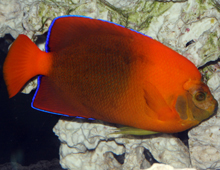
Clarion angelfish, Holacanthus clarionensis
While many angelfish have broad ranges in the Pacific or Atlantic, others are found in only a few locations. One of the more famous is this beautiful species, named for Clarion, one of the Revillagigedo Islands off the Pacific coast of Mexico. These islands are its center of distribution, but they are also found around remote Clipperton Island, and occasionally around the tip of the Baja Peninsula. Though kept in aquariums for more than 40 years, it remains a prized exhibit, collected only under special permit from the Mexican Government.
LEARN MORE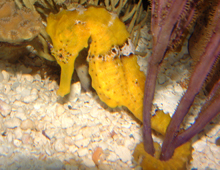
Longsnout seahorse, Hippocampus reidi
Of the three Caribbean seahorse species found in US waters, this one has the smallest distribution, being absent from the Gulf of Mexico. In the US, it is found only in North Carolina and the Atlantic Coast of Florida. Its range extends to Brazil, where it is an important species in the tropical fish trade. It is also called the Brazilian or Slender seahorse. Like most seahorses, the color can be highly variable, but tends towards bright yellows and oranges. Its favored habitat is seagrass beds and mangroves.
LEARN MORE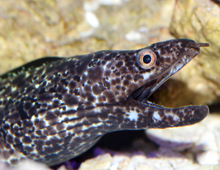
Spotted moray eel, Gymnothorax moringa
The 200 or so species of eels in the moray family have long fascinated humans. In the time of Julius Caesar, Romans kept their local species as status symbol pets in specially built pools at their Mediterranean villas. One kept thousands, and another held a funeral when his favorite pet died. Today they are popular with divers and snorkelers. Found in tropical and temperate seas around the world, they seize their prey with a unique set of “double jaws” (the second pair being in the pharynx). This species grows to seven feet, and is found in the Tropical Atlantic.
LEARN MORE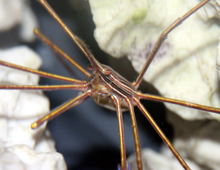
Arrow crab, Stenorhynchus seticornis
It may not be immediately apparent that this delicate-looking creature, with its four-inch leg-span, is a fairly close relative of the Japanese giant spider crab, with its 12-foot leg span, or the Snow crab, whose legs are popular at seafood buffets. Inhabiting coral reefs from Bermuda and North Carolina through the Caribbean to Brazil, this nocturnal animal preys on marine worms and other invertebrates. Quite aside from its unique appearance, it is prized by aquarists for controlling Bristle worms, which can be pests in aquariums.
LEARN MORE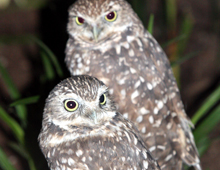
Burrowing owl, Athene cunicularia
Found all the way from the prairies of Southern Canada to Tierra del Fuego at the tip of South America, this is one of the most widespread birds of the New World. Throughout this vast range, it lives in holes in the ground. Though often awake in the daytime, its favorite times to hunt are dusk and dawn. Its prey is mostly insects and rodents. It thrives in captivity, and has bred at the DWA and in other collections. In mythology, owls were messengers of the Mayan Underworld, and companions of the Aztec Death God.
LEARN MORE
Desert cottontail, Sylvilagus audubonii
The 17 species of cottontails are entirely New World rabbits, in a different genus from domestic ones. They are distributed from Southern Canada to Northern Argentina. Eight are found in Mexico. This species, found in most of Mexico, as well as a large area of the western US, is named in honor of the famous bird painter, who also collected and painted many mammals. Cottontails make frequent appearances in the mythology and art of both the Mayans and Aztecs. In Mayan and Chinese tradition, a rabbit is the companion of the Moon Goddess.
LEARN MORE
Barred owl, Strix varia
Famed as the “Owl with the Southern Accent”, its call (frequently heard around Dallas) has been paraphrased as “Who Cooks for You-all!”. Traditionally a bird of the eastern US, with an isolated population in Southern Mexico, in recent years it has spread to the Pacific Northwest, where it out-competes and hybridizes with the threatened Northern Spotted owl. Barred owls thrive in suburbs, and quickly invade habitats where primary forest has been destroyed. They are more likely than other owls to be seen in the day time. Most of their prey is rodents.
LEARN MORE

